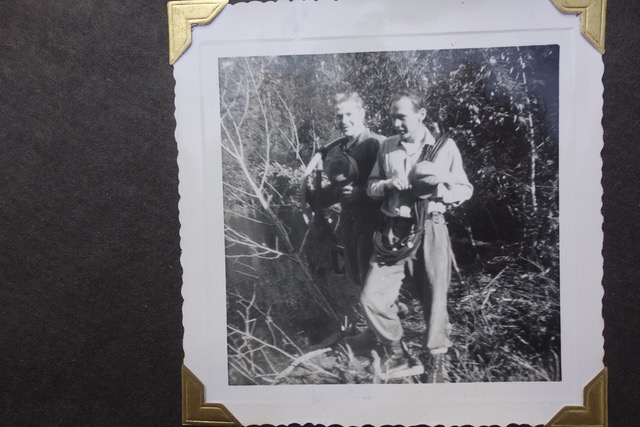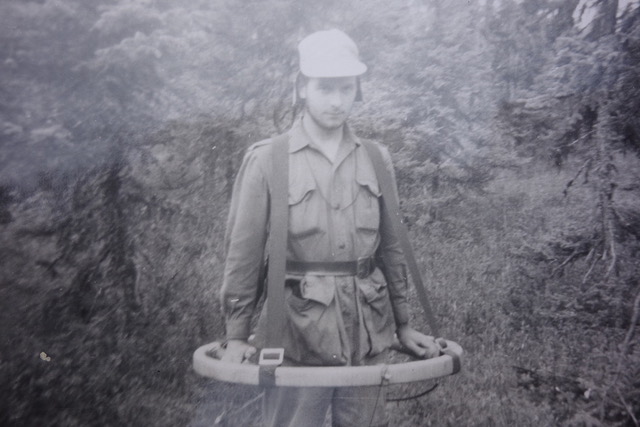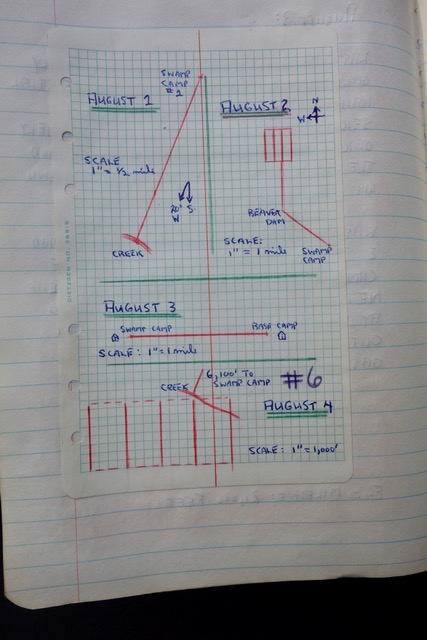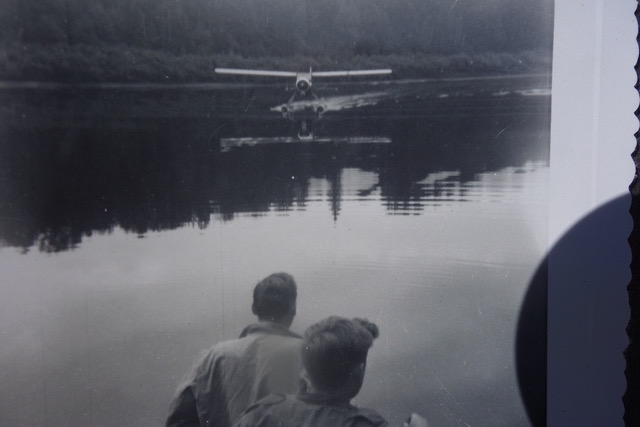EPISODE 553 PART 4 AUGUST 1 TO AUGUST 8, 1958 WORST JOB I EVER HAD IN MY LIFE
alan skeoch
March 15, 2022
DEAR DIARY
AUGUST 1, 1958Walt and I cut 6,000 feet of line south 20 degrees west from swamp camp. I think we hit our destination within 100 feet of spotlocated on our aerial photo. We struck a creek at the precise place on the photo.In the evening I patched my clothes with medical tape and canvas patches (plus some glue). It’s getting difficult to distinguishpants from patches.Distance 12,200 feet (around 2 miles)August 2, 1958

Although the northern anomaly is not quite as detailed as desirable we cannot spend another day working there.I caught a baby rabbit this morning and we placed him in a bag and hung it on a tree intending to keep him as a petbut while we were away he escaped.As we returned to camp a hurricane-like storm hit suddenly. The sun was completely blackened out and then came highvelocity winds strong enough to tear trees out by their roots throwing them around as if they were match sticks. Someof these new windfalls blocked our trail. I have never in my life seen such a storm. Ferocious. Nature weeding out thesick and the dead I suppose.
Distance covered 30,000 feet (6 miles)August 3, 1958The storm railed all night…including lightning and torrential rain. Frightening but wonderful at same time. Good thing too for nowour water supply has been replenished and, more important, the supply plane will be able to land back at our base campon the Groundhog River maybe although not expected until August 8.In the afternoon Walt and I hiked out of the swamp camp to our base camp for more food. So many trees across our trail thatwe had to cut new bypasses.
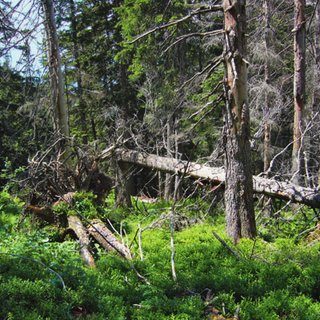
Distance travelled 21,000 feet (4 miles)August 4, 1958Completed Ronka survey of anomaly 18 south of swamp camp #1. Sure must be something beneath us since the compass seemedvery slow and contradicted itself on the backsights. Probable magnetite ore body as airborne mag suggested. We cut 5,000 feet ofnew line.Tired at night but relaxed as we traded stories around the campfire. There is a feeling of exhilaration when living this close to nature.Our plotted data profiles showed clear presence of something since both instruments reacted…the X ray magnetometer and thehorizontal loop Ronka EM unit. “How did the Ronka get its name?” “Inventor guy…physicist…works for Huntec…his machine.”The Ronka Electro Magnetic Instrument was the most important part of our survey work. And it was heavy consisting of two largehoops of closely wound copper wire (see above) . Both hoops were attached together by a 100 foot electric cable and signalswere received by a console carried by one of the men. On ordinary surveys this instrument was heavy. Our survey work meantwe had to carry a hell of lot more than the Ronka…tents, sleeping bags, food, clothes, first aid kits, axes, a buck saw, pots and pans…etc.
Vaino Ronka
The most powerful instrument is the one that is used. If that motto is true, then Vaino Ronka invented the most powerful electrical geophysical instrument. More of his VLF electromagnetic survey instruments have been used around the world than any other electrical prospecting tool.
Biography
A native of Finland, Ronka studied communications engineering and later geophysics at a university in Helsinki. After graduating, he worked for the Geological Survey of Finland and, in the early 1950s, was hired by Aeromagnetic Surveys, a division of Hunting Survey Corp., then based in Toronto.
Yet the VLF-EM was only one of Vaino’s many successful geophysical instrument designs. In the 1960s, a list was published of all the mines discovered in Canada during the previous 10 years. Out of 15 mines on the list, about 75 percent were discovered by Ronka-designed instruments.
Vaino Ronka began his work in geophysics as a research assistant on a new fixed-wing, quadrature-phase, airborne electromagnetic system at the Geological Survey of Finland. When the Hunting Group in Toronto purchased the system in 1953, Vaino moved to Toronto to help design a two-frequency version of it for commercial use. Nine months later, in September 1954, it was in operation, and won the Blue Ribbon Mining Award.
In July 1954, Vaino applied for a patent for an in-phase and quadrature towed bird helicopter EM system. When the system went into operation in 1955, it included a built-in scintillation counter, also of his design, and was one of the first transistorized commercial instruments of any kind. It again won the Blue Ribbon Award. About this time, Vaino began to think of an improved horizontal-loop ground EM system. When it appeared in the field in 1957, it set the standard for ground-based EM systems. At the end of 1958, Vaino started independent design services for geophysical instruments. One of the projects was instrumentation for Hunting’s “hydrosonde.” He also designed Hunting’s FS-I and FS2 portable seismographs and the popular Hunting time-domain IP receiver.
In 1962, Vaino founded Geonics Ltd in Toronto with partner Alex Herz. While they were in the field near Bancroft, Ontario, doing tests on the EM-IS ground EM instrument, they started picking up Morse code from VLF radio transmitters used to communicate with submarines. If these signals could be picked up as noise, Vaino figured that they could also be used as signal. Thus instead of tediously erecting a heavy, cumbersome, local transmitting station for every small piece of survey line, explorationists might simply tune in to distant VLF radio stations and use those fields to detect mineral deposits. This was the basis of his EM-16 VLF-EM receiver, which was first sold in 1965. Because of its very small size and low price the EM-16 became the best-selling electrical geophysical instrument of all time, and is still selling briskly today, under the same model name, 25 years later. Its tendency to detect weaker conductors has recently been put to very good advantage, as gold mineralization is often associated with poorly conducting fault zones.
Vaino went on to design the EM-18 as an airborne VLF instrument. Another airborne survey system, the EM-30 of Hudson Bay Mining, was also based on Vaino’s patent and ideas. In 1969, Vaino had a heart attack. It was a warning to slow down a little. He sold Geonics, and in 1973 he escaped west to Vancouver. There he designed the successful “Totem VLF-EM system which was further developed by Alex Herz. Vaino did not like the “black box” airborne gravimeter that was in use in Toronto geophysical community during 1960. He built his own gravimeter with a simple galvanometer to measure electrostatic potential between the plane and the outside air.
Vaino was recognized by SEG for his major contributions to the geophysical profession with the Fessenden Award in 1990.
August 5, 1958Walt and I began blazing trail west 248 degrees but rain began after we had gone 600 feet forcing us back to camp.“Your turn to hike back to base camps for food, Al.” I wonder if the other guys get scared when they are alonein this dense forest? Do they imagine wild things are watching them? Do they hear strange noises? Do they run?Do they stop and slowly rotate around 360 just in case there is something? They never say, so I best keep my mouthshut as well. Back at base camp I tested the radio transmitter which receives fine but just will not transmit. If weever have a serious injury, how the hell are we going to get help? Since Walt and I are swinging blazing axes almostevery day, the odds of an accident are possible.Arrived at base camp about five and cooked myself a big supper…2 cans of stew, 1 can of peaches, 1 box cookies and 3 cansof orange juice. Then packed up a lot of dry goods to carry back to Swamp Camp #1. No canned goods allowed as theyare too heavy so the guys will have to make do with a lot of rolled oats and pancakes and my favourite French toast. Oneheavy item is allowed. Peanut butter…we eat lots of that.Slung the pack on my back and headed west again hoping it would not get dark before I reached Swamp Camp #1.Arrived at 9 p.m.Distance travelled: 22,200 feet (4 miles)August 6, 1958Walt and I continued blazing our trail to Anomaly #16…west 248 degrees from Swamp Camp #1. This section of the bush iswoven with windfalls like a broken box of pick up sticks. At western edge we struck two creeks needing bridges. Constructiontook a long enjoyable time. Enjoyable? Yes, weather was perfect so we took our time. Waded in our bare feet. Then wecontinued to point of the anomaly.
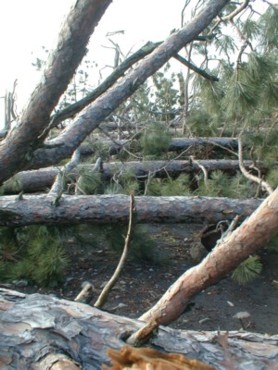
That night I collected some very strange luminous wood that we had been noticing all around Swamp Camp #1. Eerie effect lookingout of our tent at the pin pricks of light. It seems to be some kind of fungus acting upon rotting wood. Dark nights give our campa ghost-like appearance. My luminous collection was a failure though.Distance covered: 13,000 feet (2.5 miles or thereabouts)Walt and I built two of these bridges. The construction project was enjoyable … especially for our feet.August 7, 1958Tiring day as usual.Finished blazing grid for Anomaly #16, then did survey with the Ronka which gave us some high readingsthat checked out with the magnetometer. We are here in secret … wonder if any of these anomalies have been
staked as mining claims. Dr. Paterson said our crew was sent in hope that no one would know we are here. Hardly
secret if Austin Airways is hired to get us in and out. Pilots talk.
Distance covered: 20,500 feet (about 4 miles)August 8, 1958Big day today. Austin Airways Beaver arrived. Floyd and Bob packed out to Base Camp to meet the plane whileWalt and I were left behind to break up Swamp Camp #1 and follow them later. We had to sort things into two piles…thoseworth taking and those to be abandoned and burned.We arrived in afternoon and were shocked to find Floyd gone. He was being sent to a new projectin Michigan. That changes things. We will be leaderless it seems. But Bob will take over. I have been elevated a notch to second in command which means darn little.During our absence from Base Camp a black bear paid a visit and managed to get our twenty point ham which we had strungup high in a tree. Then for some reason the bear decided to get into the cook tent and rummage around. He did not usethe front door of the tent but ripped a big hole in the side.This was a really eventful day for not only did we get a new supply of food but also a big pile of mail.Why did I get so many letters?…huge pile of them. Most had American stamps and I do not know that many Americans.Some smelled of perfume. At first I thought they had been sent to the wrong person but opening the first one read“Dear Alan”. These were some kind of love letters…maybe 30 or 40 from all over the United States. One girl, writing inpencil, wanted to live with me if I could send her the fare to get here. That was a laugh. Imagine the shock she wouldfind. Perhaps I would have the greater shock though. A lot were from nurses and some of them were damn interesting…well written…lonely hearts stuff.Some of the girls told horrifying stories about their living conditions Abuse, poverty, desire to escape no matter what.How come? Why send these letters to me? Mystery was solved. In the mail pack were two letters from Russ Vanstone and Jim Romaniuk…they had sent myname and address to a lonely hearts club in the U.S. Bob, Walt and I enjoyed all the letters…read them over and overagain for the rest of the summer. Most of them made me feel sad…there were strong overtones of desperation.Distance Covered: 10,500 feet

Pilot delivering mail and taking Floyd out of the bush to a new job in Michigan.
END PART 4 AUGUST 1 TO AUGUST 8, 1958 WIRST JOBE I EVER HAD IN MY LIFE.
NEXT PART 5

